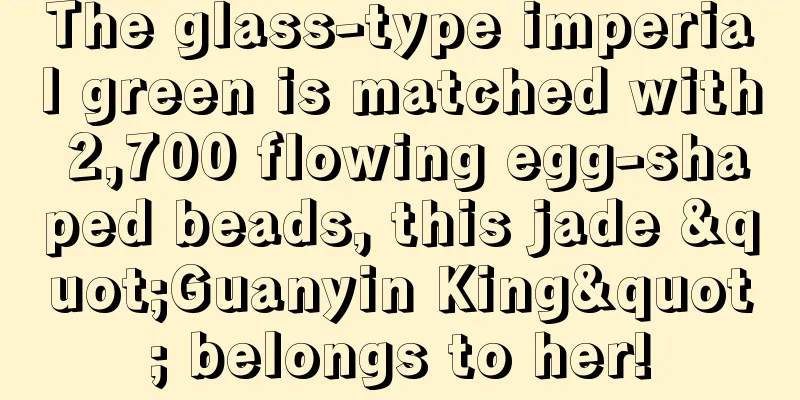The handed-down "old jadeite" worth nearly a million is actually a B-grade product! Remember these identification techniques

|
Everyone should know that jade has been introduced and popular for hundreds of years. Nowadays, if you can see old jade, it is basically passed down by the Chinese people during the Ming and Qing dynasties. Some "experts" say: "Old jadeite from the Ming and Qing dynasties or new jadeite that has been worn for a few years will be shown to be B-grade jadeite 99% of the time when tested by modern machines." So, what these "experts" mean is that if you have bought old jade, don't go for testing, because the testing is useless. They will also package fake jade, saying that if old jade is unearthed artifacts, it must have been affected by the geological environment of the tomb and caused corrosion. Jadeite handed down from generation to generation can easily be infiltrated by organic matter after being worn, passed around and circulated. Therefore, if there are organic substances in the texture of old jade, it can easily be identified as B-grade jade, and there is a possibility of misjudgment. However, scientific tests have proved that old jade can also pass the test and old jade can obtain the identification certificate for A-grade jade. We can use more advanced equipment to analyze whether the organic matter in jade is formed naturally or formed by the epoxy resin used to make B-grade jade. No means can be hidden from technology. Therefore, the problem with the “old jadeite” that has been denied by authoritative testing agencies lies with these “old jadeite” themselves. These so-called "old jades" are actually imitation jades that are filled and dyed. The real reason why merchants dare not send products for inspection is that they are afraid of being exposed! Here, let’s explain the concept again. A-grade jade refers to jade that has only undergone physical processing (to form the desired shape, such as cutting, carving, grinding, and polishing) but not chemical treatment. B-grade jade means that the jade has been chemically treated (acid etching to remove impurities) and silicone or other fillers have been added to the cavities corroded by acid. Jade B+C goods are jade that has been dyed based on B goods. Natural Grade A jade has a glassy luster and a very natural color transition. The base of B-grade jadeite that has been treated with chemical reagents is extremely clean, and due to the influence of acid washing, the color roots of the B-grade jadeite are blurred and the surface is also relatively blurred. If it is a real old jade, there will generally be a patina on its surface. This is because over a long period of time, a substance naturally forms on the surface of the jade, which is the "patina". The patina can be thick or thin. If it is jadeite from the Qing Dynasty, its color is generally brighter and the bottom is turbid. Since old jade is purely handmade, the brightness of the patina is definitely not as good as the polished luster made by modern machines. If you want to take a look at the "old jade", you can go to the Forbidden City or local museums. Nowadays, many jewelers are selling jadeite on the Internet. In addition to the "old jade" scam, there are many other scams. So, how do we identify jadeite through photos on the Internet? In fact, it is quite difficult to identify jadeite using mobile phone photos, especially some high-B (highly simulated B-grade) ones. If the photo is not clear enough, we will not be able to see the characteristics of acid etching on the surface of the jade. If the seller has high-definition photos, it will be easier and more accurate for us to judge. B-grade jadeite generally has "web patterns" on it, which are also called "spider patterns", "crab claw patterns" and "grain boundary seams" in the industry. This is one of the "evidences" that jade has been treated with acid etching and glue injection, and is an important basis for judging whether jade is natural. If you look at these reticulations with a magnifying glass, you can see that these lines are depressions formed by corrosion between the jade crystals. If we look more closely, we can also see that some glue has overflowed from the jade, leaving a dull, mesh-like luster on the polished surface of the jade. If you want to identify jadeite yourself, all you need is a 30x magnifying glass or a macro lens for a mobile phone. Using appropriate reflections, we can identify it based on its performance characteristics. However, some fakes are made with more sophisticated techniques, and the acid etching is not that severe, so the patterns are more difficult to detect, so everyone should still be more careful. Of course, the most accurate and safest identification method is to send the jade to an identification agency for scientific testing with professional machinery. fcgc66 fcpf18 |
<<: How can a novice distinguish between ABC jadeite? Two points are enough
Recommend
The beautiful feeling of first love is how I feel about Spring Color
Purple, sometimes called the most romantic color,...
How to choose a jade pendant? What are the meanings of the styles? Find out and you won’t go wrong with giving them as gifts or wearing them yourself.
There are many types of jewelry, and there are di...
How are jadeite mountains carved? How should we appreciate jadeite mountains?
Jade mountain is a kind of jade ornament for indo...
The identification standards of the Jade ABC Institute are revealed. 4 methods to select jade and learn to accurately estimate its value
Jade is divided into three categories, namely, A,...
What should you pay attention to when choosing a jade pendant?
The price of jadeite ranges from a few hundred to...
The egg-shaped ring that attracts you and makes people admire you
Perhaps only after counting too many rings of tim...
How to cut jadeite rough stone, teach you four steps
How to cut jadeite raw stone? This is a question ...
What carving methods do top jade carvers use? Introduction to Hand-carved Jade Techniques
China has accumulated thousands of years of cultu...
These eight tips will help you buy good jadeite that is worth the money
Jade is one of the most popular jewelry categorie...
How to choose a suitable egg noodle to collect?
In recent years, jade egg-shaped beads have attra...
When buying jadeite, should you choose the one with good quality or good color?
When purchasing jade jewelry, most people will fa...
What is the original color of jade? How does it differ from the secondary color of jadeite?
Jadeite, the "king of jade" deeply love...
Apart from green jadeite, which of the “non-mainstream colors” in the jade world has investment potential?
The jade world is colorful, and we won’t say much...
How to choose the ideal jade ring face? Here comes the “key point”!
Although the ring face is small, it is the most b...
What exactly is the cotton wool inside jade?
Jade is a stone polycrystalline aggregate that re...









